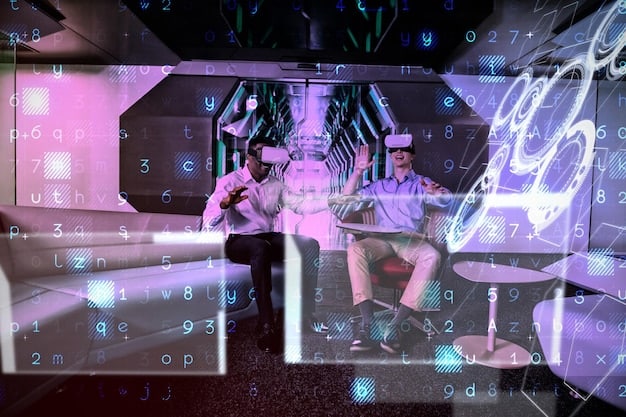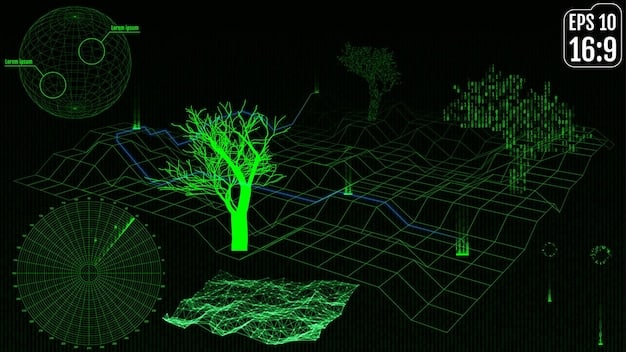AI in Game Dev 2025: Cutting-Edge Tools & Impact

The rapid integration of artificial intelligence into game development is profoundly transforming how games are created, from concept design to player experience, with 2025 showcasing a suite of advanced AI tools streamlining workflows, enhancing content, and pushing the boundaries of interactive entertainment.
In 2025, the impact of AI on game development: a look at 2025’s cutting-edge tools is undeniable, fundamentally reshaping every facet of game creation. We are moving beyond rudimentary AI scripts, entering an era where intelligent systems actively assist, augment, and even generate game content, promising unprecedented levels of complexity, immersion, and efficiency.
The Dawn of AI-Powered Game Design
The role of artificial intelligence in the introductory phases of game design is experiencing a renaissance. Gone are the days when AI was primarily relegated to NPC behavior; today, it is an integral partner in conceptualizing, prototyping, and refining game mechanics. This evolution not only accelerates the initial design sprint but also fosters an environment for unprecedented creative exploration.
AI’s analytical capabilities allow designers to quickly test countless iterations of game loops, balancing challenges, and reward systems. By simulating player interactions and predicting engagement, AI tools offer insights that were once only attainable through extensive, time-consuming playtesting. This predictive analysis ensures a more refined and compelling player experience from the very first draft of a game.
Ideation and Prototyping Acceleration
Modern AI algorithms can analyze vast datasets of existing games to identify successful patterns, emerging trends, and player preferences. This analytical power fuels ideation, suggesting novel game concepts, mechanics, and even narrative arcs that might not be immediately apparent to human designers. The speed at which these ideas can be prototyped is equally revolutionary.
- Concept Generation: AI can propose unique genre fusions, character archetypes, and world-building elements based on design parameters.
- Rapid Prototyping: Tools can quickly assemble basic game environments and interactions, allowing for immediate testing of core mechanics.
- Mechanics Balancing: AI simulates scenarios to identify exploits, difficulty spikes, or areas needing fine-tuning in gameplay.
This early integration of AI means that foundational design decisions are made with a much higher degree of data-driven confidence, reducing the risk of costly reworks in later development stages. The creative partnership between human intuition and AI’s analytical prowess is truly transformative.
Procedural Content Generation Driven by AI
One of the most impactful applications of AI in 2025’s game development landscape is its sophisticated use in procedural content generation (PCG). While PCG has existed for years, AI elevates it from rule-based systems to intelligent, context-aware generators capable of producing truly dynamic and believable game worlds, far beyond static terrains or repetitive dungeons.
AI-driven PCG can generate not just levels, but entire ecosystems, narratives, and character backgrounds that adapt to player actions and game states. This enables virtually infinite replayability and ensures that each player’s experience feels uniquely tailored, fostering deeper immersion and engagement.

Environmental and Asset Creation
AI tools can now generate highly detailed 3D models, textures, animations, and even soundscapes with minimal human input. Artists can guide the AI with high-level directives, and the system fills in the intricate details, adhering to style guides and technical specifications. This dramatically reduces the burden of manual asset creation, allowing artists to focus on conceptualization and refinement rather than repetitive production tasks.
For example, an AI could generate an entire forest, complete with varied tree species, undergrowth, lighting, and weather effects, all while maintaining strict polygon limits and performance targets. This level of automation is critical for open-world games and titles aiming for realistic fidelity without ballooning development costs and timelines. The quality and diversity of AI-generated assets are now approaching parity with handcrafted content, albeit with superior speed.
Revolutionizing Art and Animation Workflows
The traditional pipelines for game art and animation are being fundamentally reshaped by AI in 2025. AI-powered tools are automating monotonous tasks, enhancing creative output, and allowing artists to push boundaries previously restricted by manual labor. This shift liberates artists to focus on high-level creative direction and unique stylistic expression rather than the grind of individual frame or mesh adjustments.
From generating concept art to perfecting character rigging and fluid motion capture data, AI is proving to be an indispensable assistant. The ability of AI to learn from vast artistic datasets means it can understand and replicate artistic styles, generate variations, and even predict optimal animation paths with remarkable accuracy.
Smart Texturing and Material Generation
AI-driven texturing tools can now generate physically based rendering (PBR) materials from simple photographs or even text descriptions. Artists can input a reference image of a material, and the AI will extrapolate its metallic, roughness, and normal maps, saving hours of manual workflow. These systems can also generate variations based on specific environmental conditions or damage states, adding incredible depth and realism to in-game assets.
- Material Synthesis: Creating complex PBR materials from 2D images or conceptual input.
- Texture Variation: Generating diverse textures for large environments without repetitive patterns.
- Procedural Decals: Adding wear, dirt, or destruction dynamically based on game logic or environmental context.
This automation of mundane yet critical tasks ensures consistency across a game’s art style while drastically accelerating the asset pipeline. It empowers smaller teams to achieve visual fidelity rivalling that of large studios.
Automated Rigging and Animation Assistance
Rigging, the process of creating a skeletal structure for 3D models, has long been a time-consuming and technically demanding part of animation. AI tools in 2025 can semi-automate or fully automate this process, quickly generating functional rigs for complex character models. Similarly, AI enhances animation by cleaning up motion capture data, generating realistic inverse kinematics, and even predicting character movements based on behavioral patterns.
Imagine feeding raw motion capture data into an AI that automatically cleans it, removes jitters, and applies it perfectly to a rigged character model, adjusting for character proportions and physics. This is no longer futuristic; it is a reality that empowers animators to achieve higher quality results in a fraction of the time, refining realistic movement and expression. AI also assists in generating believable facial animations and lip-syncing, crucial for immersive character interactions.
AI in Game Testing and Quality Assurance
The notoriously labor-intensive and error-prone process of game testing is undergoing a profound transformation thanks to AI. In 2025, AI is not just automating regression tests; it is intelligently exploring game states, identifying obscure bugs, and even providing predictive analytics on potential performance bottlenecks. This significantly shortens QA cycles and leads to more stable, polished game releases.
Traditional QA relies heavily on human testers, which is effective but resource-intensive and often limited by human attention span and ability to systematically cover all edge cases. AI, conversely, can run millions of scenarios, detect anomalies invisible to the human eye, and learn from its testing experiences to prioritize critical areas.
Intelligent Bug Detection and Playtesting
AI agents can be trained to play games like humans, but with superhuman consistency and an inherent ability to log and report every deviation from expected behavior. These “AI testers” can explore complex open worlds, execute intricate combos, and traverse levels in ways that would take human testers weeks to replicate systematically. They can identify physics glitches, graphical artifacts, pathfinding errors, and even subtle gameplay imbalances.

Furthermore, AI can analyze crash logs and player feedback at scale, correlating specific actions or game states with reported issues to pinpoint root causes more efficiently. This proactive approach to bug detection enables developers to fix problems before they become major game-breaking issues, ensuring a smoother user experience upon launch.
Performance Optimization and Predictive Analysis
Beyond bug hunting, AI contributes to performance optimization by identifying resource hogs and inefficient code pathways. AI algorithms can analyze game engine telemetry data to predict future performance issues under various load conditions, allowing developers to optimize assets and systems preemptively. This proactive stance on performance management is crucial for maintaining smooth framerates and minimizing load times, especially in complex, large-scale titles.
AI tools can also simulate network conditions and player loads to stress-test multiplayer games, identifying potential latency issues or server capacity problems long before deployment. This level of foresight is invaluable for maintaining a high-quality online gaming experience.
Enhanced Player Experience and Personalization
The ultimate goal of game development is to create engaging experiences, and AI in 2025 is playing a pivotal role in achieving unprecedented levels of player immersion and personalization. By understanding individual player behavior, preferences, and skill levels, AI can dynamically adapt game content, difficulty, and even narrative elements to create a truly bespoke experience for each player.
This goes far beyond simple difficulty sliders; it involves intelligent systems that learn from every choice, every defeat, and every triumph a player experiences, using this data to tailor the game world to their unique journey. The result is a more captivating, challenging, and rewarding interaction that keeps players invested for longer.
Dynamic Difficulty Adjustment and Adaptive AI Opponents
AI systems can now dynamically adjust game difficulty in real-time, not just by tweaking enemy health or damage, but by altering enemy tactics, spawn rates, or even environmental hazards. This ensures that the game remains challenging without becoming frustrating, catering to both casual players and hardcore enthusiasts. The AI learns a player’s strengths and weaknesses, adapting adversaries to consistently provide an optimal level of challenge.
- Player Profiling: AI builds a detailed profile of player skill, playstyle, and preferences.
- Adaptive Opponents: Enemy AI learns and adjusts its strategies to counter the player’s evolving abilities.
- Personalized Challenges: Unique quests or encounters are generated based on individual player performance and choices.
This adaptive difficulty ensures that the player is always within their optimal challenge zone, fostering a sense of continuous progression and skill improvement rather than hitting artificial difficulty walls or becoming bored by a lack of challenge. It keeps the game fresh and engaging over extended play sessions.
Personalized Narratives and Content Delivery
Beyond gameplay mechanics, AI is enabling personalized narratives. Based on player choices, game history, and interaction patterns, AI can branch stories, generate unique character dialogue, or even create emergent side quests that feel organically integrated into the main plot. This level of dynamic storytelling makes each playthrough feel distinct and deeply personal, enhancing replayability and emotional investment.
Content delivery also benefits from AI. Imagine a game world that subtly changes its inhabitants or available quests based on what the AI detects about your preferences. If you enjoy exploration, the AI might subtly guide you towards hidden areas with environmental storytelling; if you prefer combat, more challenging encounters might organically appear. This intelligent curation of content ensures that players are always presented with experiences most likely to resonate with them.
Challenges and Ethical Considerations
While the benefits of AI in game development are immense, 2025 also brings a heightened awareness of the significant challenges and ethical considerations that accompany its widespread adoption. These issues range from data privacy and algorithmic bias to the potential impact on human creativity and employment within the industry. Addressing these concerns responsibly is crucial for the sustainable growth of AI in gaming.
The power of AI to generate content and influence player behavior comes with a responsibility to ensure fairness, transparency, and a continued emphasis on human agency and oversight. Game developers must navigate these complex waters to harness AI’s potential without compromising ethical standards or diminishing the unique human element of game creation.
Data Privacy and Algorithmic Bias
The more AI systems learn about players, the more data they collect. Ensuring the privacy and security of this player data is paramount. Developers must be transparent about data collection practices and adhere to strict privacy regulations. Equally important is the issue of algorithmic bias. If AI models are trained on biased datasets, they can perpetuate and amplify those biases in game content, leading to unfair or exclusionary experiences. This could manifest in unrepresentative character generation, culturally insensitive narratives, or even unbalanced gameplay mechanics.
Mitigating bias requires diverse training datasets, rigorous auditing of AI outputs, and constant vigilance from human developers. It’s an ongoing process that demands a proactive, ethical approach to AI implementation, ensuring that games are broadly inclusive and fair for all players, reflecting the diversity of the global gaming community.
The Future of Human Creativity and Employment
With AI automating more and more tasks, a natural concern arises about the future of human jobs in game development. While AI is currently a powerful assistant, its increasing sophistication raises questions about the balance between automation and human creativity. Will AI replace artists, designers, and testers, or will it simply augment their capabilities, freeing them to pursue more innovative and complex challenges?
The consensus in 2025 is that AI will primarily act as an augmentation tool, shifting the focus of human roles from repetitive tasks to higher-level conceptualization, curation, and oversight. Artists might become “AI wranglers,” guiding algorithms to achieve specific aesthetic outcomes. Designers will focus more on defining high-level game systems and player experiences, leveraging AI to handle the minute details. However, the industry must proactively train its workforce in AI literacy and collaboration to ensure a smooth transition and harness the full potential of this technological partnership. The emphasis will shift from creation by hand to creation by intelligent guidance.
The Economic Impact and Accessibility
The integration of advanced AI tools in game development has significant economic implications, extending beyond mere cost savings. In 2025, AI is not only making game development more efficient for large studios but also dramatically lowering the barrier to entry for independent developers and smaller teams. This democratization of powerful tools is fostering a new wave of innovation and diversity in the gaming industry, leading to more accessible and varied games for players worldwide.
The ability to achieve high production values with reduced resource allocation means that niche genres and experimental concepts can now be explored by teams that previously lacked the budget or personnel. This diversified landscape benefits the entire ecosystem, from creators to consumers.
Cost Reduction and Efficiency Gains
AI’s ability to automate core development tasks directly translates to substantial cost reductions. Less time spent on manual asset creation, bug fixing, and repetitive testing means fewer man-hours, allowing budgets to be stretched further or reallocated to other areas of development, such as deeper narrative design or innovative gameplay mechanics. For large studios, these efficiency gains can be enormous, accelerating time-to-market and increasing overall profitability.
Smaller studios, which often operate on shoestring budgets, benefit even more dramatically. AI tools provide them with capabilities that were once exclusive to AAA development, such as advanced procedural generation for vast open worlds or sophisticated character animation. This levels the playing field significantly, enabling independent developers to compete on a visual and technical level previously unimaginable without massive investment.
Democratizing Game Creation
Perhaps one of the most exciting aspects of AI in 2025 for game development is its democratizing effect. User-friendly AI interfaces and pre-trained models are making it easier for aspiring developers with limited technical or artistic skills to bring their game ideas to life. Someone with a strong narrative concept but weak programming skills might leverage AI to generate dialogue, character models, and basic game logic. An artist without a deep understanding of game engines could use AI to automatically optimize their assets and integrate them into a playable prototype.
The rise of no-code/low-code AI game development platforms is empowering a new generation of creators. This increased accessibility will lead to a broader array of unique and experimental games, catering to diverse tastes and perspectives. It means more people can enter the creative space, fostering a richer and more vibrant gaming ecosystem for everyone. This pushes the boundaries of who can be a game developer, creating a more inclusive industry.
| Key Area | AI’s Impact |
|---|---|
| 🚀 Game Design | Accelerates concept generation, prototyping, and mechanics balancing. |
| 🧩 Content Generation | Enables dynamic generation of environments, assets, and even narratives. |
| 🧪 Quality Assurance | Automates bug detection, performance testing, and predictive analysis. |
| ✨ Player Experience | Personalizes difficulty, narratives, and content delivery for each player. |
Frequently Asked Questions About AI in Game Development
▼
AI personalizes game experiences by analyzing individual player behavior, skill levels, and preferences. It dynamically adjusts difficulty, enemy tactics, and even narrative elements, such as branching storylines or unique quests, to create a bespoke and engaging journey tailored to each player’s unique style.
▼
No, advanced AI in 2025 primarily acts as an augmentation tool rather than a replacement. It automates repetitive tasks like rigging, texturing, and basic asset generation, allowing human artists and designers to focus on higher-level creative direction, conceptualization, ethical oversight, and unique stylistic expression, fostering a collaborative synergy.
▼
Key ethical concerns include data privacy and algorithmic bias. AI systems collect extensive player data, necessitating strict privacy protocols. Additionally, if trained on biased datasets, AI can perpetuate and amplify biases in game content, leading to unfair or exclusionary experiences, requiring constant vigilance and diverse data.
▼
AI significantly improves QA by automating intelligent bug detection and playtesting. AI agents can explore millions of scenarios, identify obscure bugs, and perform comprehensive stress tests for performance issues far more efficiently than human testers, leading to more stable and polished game releases and shorter development cycles.
▼
AI dramatically reduces development costs through automation of tasks like asset creation and testing, freeing up resources. It also democratizes game creation by making powerful tools accessible to smaller independent studios and aspiring developers, fostering more diverse and innovative games by lowering the barrier to entry significantly.
Conclusion
The year 2025 heralds a new era for game development, one profoundly shaped by the transformative power of artificial intelligence. From accelerating initial design concepts and revolutionizing content creation to optimizing testing processes and personalizing player experiences, AI is no longer just a feature within games but a fundamental co-creator. While challenges related to ethics and employment remain, the overall trajectory points towards a future where AI and human ingenuity collaborate to push the boundaries of what is possible in interactive entertainment, making game creation more efficient, accessible, and ultimately, more magical for players worldwide. The tools available are not merely incremental upgrades; they represent a paradigm shift, promising games of unparalleled depth, complexity, and bespoke engagement.





